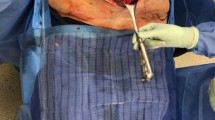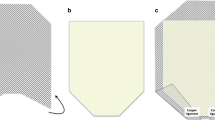Abstract
Large complex ventral hernias act as tissue expanders for skin and subcutaneous fat. The purpose of this study is to evaluate outcomes of total abdominal wall reconstruction with component separation, posterior reinforcement, and vertical abdominoplasty in patients with large complex ventral hernias. Between 2010 and 2014, 58 patients underwent total abdominal wall reconstruction with component separation, intra-abdominal reinforcement, and vertical abdominoplasty. Between 2010 and 2012, patients underwent the conventional technique of component separation, while a perforator-preserving technique was performed during 2013 and 2014. Reinforcement material used was either synthetic mesh in clean cases or biologic mesh if contamination was present. All of the excessive skin and subcutaneous fat was removed in a vertical fashion. Data were analyzed with Mann–Whitney’s U test or Fisher’s exact test, as indicated. There were 27 moderately complex and 31 majorly complex hernias. Mean hernia size was 16 × 12 cm. The mean size of the removed skin island was 21 × 12 cm. Patients with contamination during the repair had longer in-hospital stays. Overall the local wound complication rate was 24 %, and was lower with the perforator-preserving technique compared to the conventional technique of component separation (11 vs. 48 %; OR 0.13, CI 0.03–0.5; p = 0.003). The overall postoperative morbidity rate was higher in the presence of contamination, and in patients with lower preoperative serum albumin levels. Mean total follow-up was 14 months with a 1-year recurrence-free survival of 96 %.
Level of Evidence IV
This journal requires that authors assign a level of evidence to each article. For a full description of these Evidence-Based Medicine ratings, please refer to the Table of Contents or the online Instructions to Authors www.springer.com/00266.






Similar content being viewed by others
References
Goodenough CJ, Ko TC, Kao LS, Nguyen MT, Holihan JL, Alawadi Z, Nguyen DH, Flores JR, Arita NT, Roth JS, Liang MK (2015) Development and validation of a risk stratification score for ventral incisional hernia after abdominal surgery: hernia expectation rates in intra-abdominal surgery (the HERNIA Project). J Am Coll Surg 220:405–413
Breuing K, Butler CE, Ferzoco S, Franz M, Hultman CS, Kilbridge JF, Rosen M, Silverman RP, Vargo D (2010) Incisional ventral hernias: review of the literature and recommendations regarding the grading and technique of repair. Surgery 148:544–558
Slater NJ, Montgomery A, Berrevoet F, Carbonell AM, Chang A, Franklin M, Kercher KW, Lammers BJ, Parra-Davila E, Roll S, Towfigh S, Van Geffen E, Conze J, Van Goor H (2014) Criteria for definition of a complex abdominal wall hernia. Hernia 18:7–17
Fischer JP, Tuggle CT, Wes AM, Kovach SJ (2014) Concurrent panniculectomy with open ventral hernia repair has added risk versus ventral hernia repair: an analysis of the ACS-NSQIP database. J Plast Reconstr Aesthet Surg 67:693–701
Fischer JP, Basta MN, Wink JD, Wes AM, Kovach SJ (2014) Optimizing patient selection in ventral hernia repair with concurrent panniculectomy: an analysis of 1974 patients from the ACS-NSQIP datasets. J Plast Reconstr Aesthet Surg 67:1532–1540
Ramirez OM, Ruas E, Dellon AL (1990) “Components separation” method for closure of abdominal-wall defects: an anatomic and clinical study. Plast Reconstr Surg 86:519–526
Butler CE, Campbell KT (2011) Minimally invasive component separation with inlay bioprosthetic mesh (MICSIB) for complex abdominal wall reconstruction. Plast Reconstr Surg 128:698–709
Berard F, Gandon J (1964) Postoperative wound infections: the influence of ultraviolet irradiation of the operating room and of various other factors. Ann Surg 160(Suppl 2):1–192
Wang HD, Singh DP (2013) The use of indocyanine green angiography to prevent wound complications in ventral hernia repair with open components separation technique. Hernia 17:397–402
Patel KM, Bhanot P, Franklin B, Albino F, Nahabedian MY (2003) Use of intraoperative indocyanine-angiography to minimize wound healing complications in abdominal wall reconstruction. J Plast Surg hand Surg 47:476–480
Van der Beek ES, Te Riele W, Specken TF, Boerma D, Ramshorst B (2010) The impact of reconstructive procedures following bariatric surgery on patient well-being and quality of life. Obes Surg 20:36–41
Albino FP, Patel KM, Nahabedian MY, Sosin M, Attinger CE, Bhanot P (2013) Does mesh location matter in abdominal wall reconstruction? A systematic review of the literature and a summary of recommendations. Plast Reconstr Surg 132:1295–1304
Author information
Authors and Affiliations
Corresponding author
Ethics declarations
Conflict of interest
The authors declare that they have no conflict of interest.
Rights and permissions
About this article
Cite this article
Espinosa-de-los-Monteros, A., Avendaño-Peza, H., Gómez-Arcive, Z. et al. Total Abdominal Wall Reconstruction with Component Separation, Reinforcement, and Vertical Abdominoplasty in Patients with Complex Ventral Hernias. Aesth Plast Surg 40, 387–394 (2016). https://doi.org/10.1007/s00266-016-0628-7
Received:
Accepted:
Published:
Issue Date:
DOI: https://doi.org/10.1007/s00266-016-0628-7




